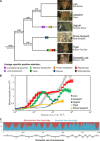Genome-wide signatures of complex introgression and adaptive evolution in the big cats
- PMID: 28776029
- PMCID: PMC5517113
- DOI: 10.1126/sciadv.1700299
Genome-wide signatures of complex introgression and adaptive evolution in the big cats
Abstract
The great cats of the genus Panthera comprise a recent radiation whose evolutionary history is poorly understood. Their rapid diversification poses challenges to resolving their phylogeny while offering opportunities to investigate the historical dynamics of adaptive divergence. We report the sequence, de novo assembly, and annotation of the jaguar (Panthera onca) genome, a novel genome sequence for the leopard (Panthera pardus), and comparative analyses encompassing all living Panthera species. Demographic reconstructions indicated that all of these species have experienced variable episodes of population decline during the Pleistocene, ultimately leading to small effective sizes in present-day genomes. We observed pervasive genealogical discordance across Panthera genomes, caused by both incomplete lineage sorting and complex patterns of historical interspecific hybridization. We identified multiple signatures of species-specific positive selection, affecting genes involved in craniofacial and limb development, protein metabolism, hypoxia, reproduction, pigmentation, and sensory perception. There was remarkable concordance in pathways enriched in genomic segments implicated in interspecies introgression and in positive selection, suggesting that these processes were connected. We tested this hypothesis by developing exome capture probes targeting ~19,000 Panthera genes and applying them to 30 wild-caught jaguars. We found at least two genes (DOCK3 and COL4A5, both related to optic nerve development) bearing significant signatures of interspecies introgression and within-species positive selection. These findings indicate that post-speciation admixture has contributed genetic material that facilitated the adaptive evolution of big cat lineages.
Figures




Similar articles
-
Supermatrix and species tree methods resolve phylogenetic relationships within the big cats, Panthera (Carnivora: Felidae).Mol Phylogenet Evol. 2010 Jul;56(1):64-76. doi: 10.1016/j.ympev.2010.01.036. Epub 2010 Feb 4. Mol Phylogenet Evol. 2010. PMID: 20138224
-
Massive inter-species introgression overwhelms phylogenomic relationships among jaguar, lion, and leopard.Syst Biol. 2025 Mar 25:syaf021. doi: 10.1093/sysbio/syaf021. Online ahead of print. Syst Biol. 2025. PMID: 40128107
-
Comparison of carnivore, omnivore, and herbivore mammalian genomes with a new leopard assembly.Genome Biol. 2016 Oct 11;17(1):211. doi: 10.1186/s13059-016-1071-4. Genome Biol. 2016. PMID: 27802837 Free PMC article.
-
Schrodinger's scat: a critical review of the currently available tiger (Panthera Tigris) and leopard (Panthera pardus) specific primers in India, and a novel leopard specific primer.BMC Genet. 2016 Feb 9;17:37. doi: 10.1186/s12863-016-0344-y. BMC Genet. 2016. PMID: 26860950 Free PMC article. Review.
-
Comparative genomics and the study of evolution by natural selection.Mol Ecol. 2008 Nov;17(21):4586-96. doi: 10.1111/j.1365-294X.2008.03954.x. Mol Ecol. 2008. PMID: 19140982 Review.
Cited by
-
Comparative assessment of genotyping-by-sequencing and whole-exome sequencing for estimating genetic diversity and geographic structure in small sample sizes: insights from wild jaguar populations.Genetica. 2024 Dec;152(4-6):133-144. doi: 10.1007/s10709-024-00212-5. Epub 2024 Sep 26. Genetica. 2024. PMID: 39322785
-
Complex Evolutionary History With Extensive Ancestral Gene Flow in an African Primate Radiation.Mol Biol Evol. 2023 Dec 1;40(12):msad247. doi: 10.1093/molbev/msad247. Mol Biol Evol. 2023. PMID: 37987553 Free PMC article.
-
Comparative genomics provides new insights into the remarkable adaptations of the African wild dog (Lycaon pictus).Sci Rep. 2019 Jun 6;9(1):8329. doi: 10.1038/s41598-019-44772-5. Sci Rep. 2019. PMID: 31171819 Free PMC article.
-
Phylogenomics Reveals High Levels of Incomplete Lineage Sorting at the Ancestral Nodes of the Macaque Radiation.Mol Biol Evol. 2023 Nov 3;40(11):msad229. doi: 10.1093/molbev/msad229. Mol Biol Evol. 2023. PMID: 37823401 Free PMC article.
-
Efficient Bayesian inference under the multispecies coalescent with migration.Proc Natl Acad Sci U S A. 2023 Oct 31;120(44):e2310708120. doi: 10.1073/pnas.2310708120. Epub 2023 Oct 23. Proc Natl Acad Sci U S A. 2023. PMID: 37871206 Free PMC article.
References
-
- J. A. Coyne, H. A. Orr, Speciation (Sinauer Associates, 2004).
-
- Fontaine M. C., Pease J. B., Steele A., Waterhouse R. M., Neafsey D. E., Sharakhov I. V., Jiang X., Hall A. B., Catteruccia F., Kakani E., Mitchell S. N., Wu Y.-C., Smith H. A., Love R. R., Lawniczak M. K., Slotman M. A., Emrich S. J., Hahn M. W., Besansky N. J., Extensive introgression in a malaria vector species complex revealed by phylogenomics. Science 347, 1258524 (2015). - PMC - PubMed
-
- Lamichhaney S., Berglund J., Almén M. S., Maqbool K., Grabherr M., Martinez-Barrio A., Promerová M., Rubin C.-J., Wang C., Zamani N., Grant B. R., Grant P. R., Webster M. T., Andersson L., Evolution of Darwin’s finches and their beaks revealed by genome sequencing. Nature 518, 371–375 (2015). - PubMed
-
- Johnson W. E., Eizirik E., Pecon-Slattery J., Murphy W. J., Antunes A., Teeling E., O’Brien S. J., The late miocene radiation of modern felidae: A genetic assessment. Science 311, 73–77 (2006). - PubMed
Publication types
MeSH terms
LinkOut - more resources
Full Text Sources
Other Literature Sources
Miscellaneous

